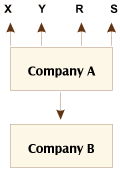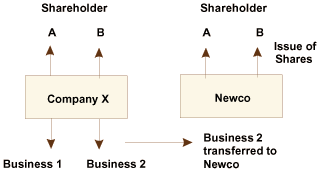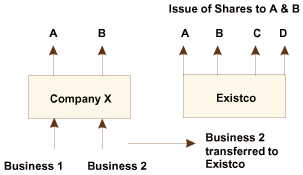Revenue Tax Briefing Issue 48, June 2002
Capital Gains Tax
Introduction
This article deals with ‘paper for paper’ transactions involving the exchange of shares and/or the transfer of business assets or undertakings in return for shares. The exchange of shares or transfer of assets are disposals for capital gains tax purposes. However, since there is often no actual cash passing hands the legislation provides for relief from capital gains tax.
The article deals primarily with the reliefs provided by Section 586 TCA 1997 (Company amalgamations by exchange of shares) and Section 587 TCA 1997 (Company reconstructions and amalgamations). It also deals with Section 624 TCA 1997 (exemption from charge under Section 623 TCA 1997 which provides for liability where a company ceases to be a member of a group) in the case of certain mergers. The article will be of benefit to those practitioners who deal with company reconstructions and amalgamations.
Company Amalgamations by Exchange of Shares (Section 586 TCA 1997)
The effect of this section is that where a company issues shares or debentures to a person in exchange for shares or debentures of another company, the exchange is treated as if the two companies were one and the same company and the exchange of shares was a reorganisation of its share capital. Thus, the exchange is not a disposal for capital gains tax purposes.
The section applies only where the company issuing the shares or debentures has or, in consequence of the exchange, will have control of the other company, or makes the issue as a result of a general offer to members of the other company or any class of them on condition that if it were satisfied it would have control of the other company.
For example:
- Position before exchange of shares:

- Company A issues shares to the shareholders of Company B in exchange for their shares in company B
- Position, post exchange:

As a result X, Y, R & S are the shareholders of Company A and that company controls Company B.
Examples of Control:
Examples of control would include where the issuing company:
- Acquires part or all of the minority share or debenture holdings in an existing subsidiary
- Makes a successful take-over bid for the other company
- Completes a successful take-over bid for the other company by acquiring the rest of its shares or debentures
- Has made unconditional a general offer which was previously conditional on its acquiring control of the other company. Thus, if X Ltd. as part of a take-over bid made an offer to acquire the shares of Y Ltd. on condition that the offer is accepted as to more than 50 per cent of that company’s share capital and then, during the negotiations, makes the offer unconditional, the section applies even if the take-over bid fails.
The provisions of Section 586 do not apply unless the exchange is for bona fide commercial reasons and is not part of a tax avoidance scheme.
Company Reconstructions and Amalgamations (Section 587)
Where, under a scheme of reconstruction or amalgamation, a company issues shares or debentures to the shareholders of another company in respect of and in proportion to their existing holdings in shares or debentures, those holdings being retained by them or cancelled, the transaction is treated as an exchange of shares. This comes within the rules applicable to a reorganisation of share capital so that the new holding is treated in the hands of the shareholder as if it were the original holding with no consequent charge to capital gains tax at the time of the exchange. For this purpose, “shares” include stock, debentures and interests in a company with no share capital, held by members of the company. It also includes options in relation to such “shares”.
A reconstruction takes place where ‘an undertaking’ carried on by a company is in substance preserved and transferred to another company consisting substantially of the same shareholders (“substantial identity of shareholding”). It is only required that substantial identity of shareholding exists immediately after the transfer. It is not necessarily significant that as a next step the shares in the new company are sold. However, it is essential that the reconstruction must not be in any way contingent on the subsequent sale or transfer of shares. Furthermore, the contract for the sale of shares must not be in existence prior to the issue of shares by the new company.
Revenue will accept that the transfer of a 100% shareholding constitutes the transfer of an undertaking.
An amalgamation is the blending of two or more existing undertakings into one undertaking, the shareholders of each blending company becoming substantially the shareholders in the company, which carries on the blended undertaking.
A reconstruction or amalgamation would also take place where the transfer is a transfer of part of a business;. provided that the part can exist as a business in its own right. However, there must be a segregation of trades or businesses and not merely the segregation of assets.
The basic philosophy behind schemes of reconstruction and amalgamation is that the original shareholders keep an interest in the original business.
Example - Reconstruction:
Company X carries on two businesses. Its shareholders are A and B. Newco issues shares to the shareholders of Company X, in proportion to their existing shareholding, in exchange for the transfer of Business 2 to Newco. This constitutes a reconstruction since Business 2 is carried on by a company, which has the same shareholders as Company X.

Example - Amalgamation:
Again, Company X carries on two businesses. Its shareholders are A and B. An existing company (Existco), whose shareholders are C and D, issue shares to the shareholders of Company X in exchange for the transfer of Business 2 to Existco. This constitutes an amalgamation as Business 2 is carried on by a company, whose shareholders are an amalgamation of the participating companies.

Relief
Shareholder
Section 587(2) provides that where in consequence of the arrangements referred to above, a shareholder or debenture holder in a company receives shares or debentures in the acquiring company and either retains his/her old shares or debentures or has them cancelled, he/she is deemed to have exchanged his/her old shares or debentures for his/her new holding. The original shares and the new holding are treated as the same asset acquired as the original shares were acquired as respects cost and date of acquisition. The consequence of this rule is that any gain or loss on the original shares is treated as accruing only when the new holding or part of it is disposed of.
Transfer of Business Assets
Section 615 operates where, on a reconstruction or amalgamation, a company takes over the whole or part of the business of another company and that other company receives no consideration for the transfer of the business other than the taking over of its liabilities. The section provides that no corporation tax is to be charged in respect of chargeable gains accruing to the transferor company, but the transferee company is to be treated as if it had acquired the assets at the time and the price at which they were acquired by the transferor company. This section does not apply to trading stock.
To qualify for relief under this section-
- The scheme must involve the transfer of the whole or part of a company’s business to another company
- The acquiring company must be resident in the State at the time of the acquisition or the assets are chargeable assets in relation to that company immediately after the transfer
- The transferor company must be resident in the State at the time of the acquisition or the assets are chargeable assets in relation to that company immediately before the transfer
- The transferor company must receive no consideration for the transfer, apart from the other company taking over the whole or part of its business liabilities.
The transferor company is treated as having disposed of the assets with no loss or gain arising. The transferee company, for the purposes of calculating indexation relief on eventual disposal, is treated as having acquired the assets at the time and price at which they were acquired by the transferor company.
Consequently, when the acquiring company eventually sells the assets to some third party the gains made by both the first and the second companies will at that time be brought into charge and indexation relief applies accordingly.
Relief does not apply to the issue of shares by a company under a scheme of reconstruction or amalgamation unless that scheme is effected for bona fide commercial reasons and not as part of a tax avoidance scheme.
Where a bona fide reconstruction takes place to which the provisions of Section 587 and 615 apply, it is not the practice of Revenue to invoke a distribution charge under Section 130 TCA 1997.
Transactions involving family company partitions are dealt with in Tax Briefing Issue 44.
Exemption from Section 623 TCA 1997 for certain mergers (Section 624 TCA 1997)
Section 623 TCA 1997 sets out the charge to tax, on one or more group members leaving a group of companies, in respect of assets the company leaving the group acquired from other group companies within a period of 10 years immediately preceding the time the company leaves the group. The charge deferred under Section 617 TCA 1997 is effectively reinstated.
Section 624 TCA 1997 provides that in order to facilitate company mergers, Section 623 TCA 1997 is not to apply if all the following conditions are satisfied, when a company leaves the group as part of a merger
- There are bona fide commercial reasons for the merger
- Avoidance of tax is not the main or one of the main purposes
- The merger is within the definition in Section 624(2).
For the purposes of this section a merger is an arrangement whereby:
- A company(ies) outside a group of companies acquires an interest in the whole or part of the business carried on by the company leaving the group (Company X) and
- The group of companies of which Company X was a member acquires an interest in the business carried on by each acquiring company or, in the case of a consortium operating through a joint operating company, by a company 90 per cent or more of whose ordinary share capital is owned by the acquiring companies.
In Addition
- Not less than 25 per cent by value of the interests acquired by each party are to be by way of ordinary share capital, the balance (as regards the acquisition by Company X or its group) being by way of debentures or shares
- The value or aggregate values of the interests acquired by both parties to the merger are to be substantially of the same value
- The consideration received by the group of companies of which Company X ceases to be a member is to be applied in the acquisition of the interest in the other group of companies. The words of the Act ensure that the consideration may be wholly in shares or partly in cash and partly in shares provided that the part in cash is applied to purchase the relevant shares.
- The acquisition must be otherwise than with a view to disposal
- For the purposes of Section 624 a member of a group can be treated as carrying on as one business, the activities of the group
- In Section 624 the word “company” can include a company not resident in the EU.
Advance Opinions
In any situation where you are in doubt about whether the particular provisions of either Sections 586, 587 or 624 TCA apply, Revenue will, on request, give an opinion on whether the proposed transaction comes within the legislation. (See pages 11 to 14.)
Requests, with full details, should be sent to:
Office of The Chief Inspector of Taxes,
Technical Services, CGT Unit,
Setanta Centre,
Nassau St.,
Dublin 2.
